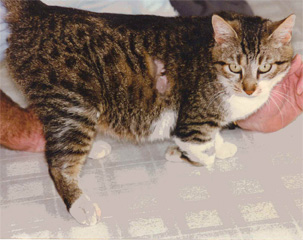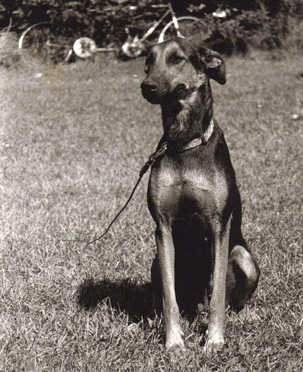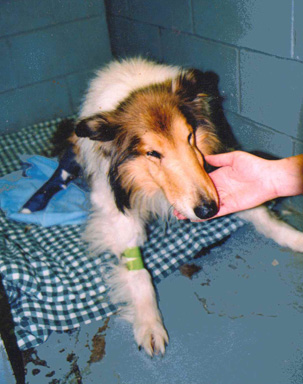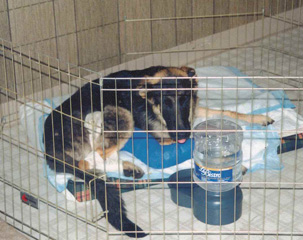
AC Paw - A History of Success
(For a printable version of this story as a PDF file, please click here)
After just celebrating their 16th anniversary, AC Paw (Antrim County Pet & Animal Watch) is approaching the milestone of having saved 6,000 cats and dogs. It's quite an accomplishment for what started out to be just two people in the beginning. But those two people weren't just anyone - they were Brian Manley and June McGrath. They held within them the key ingredients for an animal rescue to be successful - compassion, motivation, organization and dedication. Over the years, they have been recognized for their efforts by receiving a Community Service Award from the Michigan Veterinary Medical Association in 2003 and Kindred Spirit Awards from the Doris Day Foundation in 2003 and 2004.
Saving cats and dogs isn't easy. In fact, most of the time it's a very stressful, very unforgiving cause to be involved in. You literally make life and death decisions every day. You have to deal with irresponsible pet owners whose actions often manifest themselves in an animal being abused, neglected or just plain unwanted.
Many times, rescue groups have to say no when asked to take in pets because there are just not enough foster homes to take in all the unwanted animals that they get calls for. And when you get 30 or more calls and emails in one day, it can really get to you. Sometimes these calls haunt animal rescuers for years. They wonder whatever became of the cat or dog that was in need. It's heartbreaking, but decisions often have to be made about who can be helped depending on the volunteers and finances available. Sometimes the animals in the worse situation have to be helped first because the others are still safe in a warm, dry house. With AC Paw, even the sick and injured pets have a chance to be rescued. AC Paw has an exceptionally liberal intake policy. Old dogs, orphaned kittens, injured animals and parvo puppies – they all receive equal consideration and approximately one in every five intakes is such a challenge. Because of these challenges, every day can be an emotional rollercoaster.
As hard as things get sometimes, the rewards of rescuing the life of a cat or dog really can't be measured - it's simply pure joy when a life is saved and the animal is placed in a new home with caring pet owners. Over the course of 16 years, more than 420 orphaned kittens were cared for because of the countless hours that AC Paw spent bottle feeding and nursing them back to health (June alone cared for about 200 of these baby kittens.) Forty-seven dogs are alive because AC Paw fought against Parvo to save their lives. Other behavioral issues and illnesses like distemper or heartworm have also been conquered so that a healthy animal could find a loving home. Sometimes, it's when things seem the darkest when AC Paw volunteers get a new reason to go on. What motivates them? They get a thank you from a happy new pet owner or they are able to save a little life from the cold. Many times they are stopped by people who tell them how much they love their AC Paw dog or cat. It is after these times that the volunteers realize it's all worth it. They're making a difference.
There are many dedicated volunteers who help AC Paw to make that difference. Some volunteers have been with them for more than fourteen years like Louise Kozan and some have just signed on. Some are fosters and others help with fundraising or help adopt out the animals. Everyone is important. AC Paw has about ten regular foster homes who have stayed on long-term and they are very grateful for them. Finding foster homes is always a priority because it means saving a life. AC Paw is 100% volunteer, with no paid staff. Each year thousands of hours of work (approximately 10,000) are required to keep AC Paw going and the only compensation is the satisfaction of a job well done. Each animal receives excellent vet care for all their needs.The money saved by having no paid staff is directed to quality care for the cats and dogs. Brian commented about their great volunteers, "I am so proud of our volunteers and I hope people will look for our newsletter coming out around Memorial Day, highlighting many of them and their efforts."
So how did AC Paw get started? By April of 1995, Brian had lost about 80% of his vision to a retinal degeneration and would regularly have June read the editorial page from the local paper to him each week. One letter she read kept nagging at him for days after hearing it. It was from a local physician who had found a stray dog but was very adamant about not taking it "to the pound." Brian wondered why he was so determined not to go there. He hadn't thought much about animal issues before that.
A few days later, Brian asked June if they could go over to the pound together and check it out. When they visited their local county pound the following week, they were stunned. Their first realization was that Animal Control was a very low priority in their county budget (since then, it's greatly improved). Although Brian could see very little, it was not hard to tell the building was shabby and poorly financed. It was an old pole building with no amenities. It was depressing.
They visited the animals and Brian remembers taking an old Beagle outside on leash and she went to the bathroom for what seemed like five minutes. She seemed to be very sad and Brian felt awful when he had to put her back in her dingy kennel space. Other dogs were howling and whining, some almost as though they knew their probable fate.
On the way out, Brian and June spoke with a part time Animal Control Officer who answered some basic questions. When they returned to their vehicle June asked naively, "I wonder why they have so many dog collars on the wall?" Brian had not been able to see them but she explained there were many many collars, some with tags still attached, on nails on the wall. "Think about it.", Brian replied, waiting for the obvious to hit her. She literally gasped when it reality hit her, that after the euthanasia they put each dog's collar on a nail. The next time they visited they were all gone.
After that visit, they promised themselves to do something to help the situation. But what? At first, June took photos and made posters, calling attention to animals who needed a home. For the first few week, they were hopeful. Then they learned that those animals had still been killed after not finding homes for them even with the extra attention. They tried volunteering their help to another gal who had a very small operation, but it became obvious after about six weeks she wasn't interested in their help.
How could they help animals from being euthanized?
The first rescue that June and Brian did was a young female Doberman named Keil. Her "family" brought her to the pound just a day before she had five puppies. They got near her kennel and it was obvious that Keil was conflicted. She approached and wagged her tail looking for attention, but then would back up by her puppies and bark. June started to photograph the little family but neither of them were happy with just taking pictures, as this approach had not helped any of the previous animals survive euthanasia. June and Brian agreed that the only way to know they were saving Keil was to take her and her puppies with them. So they told the part time helper that they wanted to take them all. She seemed surprised but was happy to let them go.
As the five puppies were loaded into a box and they checked Keil out at the desk, Brian and June heard the workers hurry and clean the kennel to make room for a new dog that was coming in any minute. It was at that moment the idea for AC Paw was conceived. The instant need for the space where they had just saved Keil was already assigned to a new poor soul. The always-filled space in the pound was a big factor in Brian and June's decision that an organization was needed - something much more than just the two of them. It was clear that the problem was overwhelming.
They would find Keil and the puppies a home from their own house and ensure they were not euthanized. But what about all the other animals at the pound? They couldn't take them all with them.
It took a few weeks for Brian to work out the plan and come up with the name AC Paw, but the seed was planted in that moment of pressure for kennel space. They wished they had taken the other animals out instead of photographing them but there was nothing they could do for those animals at that time. All they could do was promise to work harder for other dogs and cats in the future.
The foster care system was born out of necessity as they had no money and limited space. In that first six months, AC Paw got all adult dogs spayed or neutered and sent puppies out on a contract committing people to get it done. They quickly became disillusioned with the contract as a successful sterilization method. In 1996, they shifted to early spay/neuter and soon their standard was to get everyone done prior to adoption. June and Brian feel this is even more important than being "no kill". AC Paw has also facilitated an additional 900 spay/neuter operations in the community. This has prevented many animals from entering an already overcrowded population stream.
June and Brian were told that 700 to 800 animals a year were brought to the Antrim County Shelter and that over half were euthanized. Stories circulated about deplorable conditions in the sixties and seventies and one Sheriff's Deputy said "off the record" that back then, they sometimes took animals somewhere and shot them. Brian indicated that he was appalled and the Deputy said in defense, "It was all we could afford." Even worse stories were put forward but Brian found them hard to believe and could not substantiate any on them.
Brian is now happy to report that conditions have improved dramatically in Antrim County, as some eight or nine years ago the county finally decided to put some money into the problem and constructed a very nice shelter. They also added an Animal Control Officer to the understaffed operation. For some years, AC Paw have been working well with Animal Control and see that they work hard and care for the animals. They have a good partnership.
Another memorable rescue was Shubie (Shoe-bee) the kitty. Shubie was just moments away from being euthanized when Brian and June found her. She was not able to use her hind quarters and showed signs of neurological damage, a result of the horrible abuse and tormenting from some awful neighborhood kids. A witness said kids had shot her with a pellet gun and stabbed her with a stick in her side. They also saw that the cat must have recently had kittens as she had full milk sacks but no kittens were ever found after a search was done. With all the cats at the pound this one seemed an obvious choice for euthanasia and Brenda, the Animal Control officer, had the needle in her hand. But she hesitated. She asked if AC Paw had any interest in the cat even though she didn't look good. There was just something about her – so June and Brian took her to the vet for evaluation. She was given antibiotics and anti inflammatory medicine. Surprisingly, with lots of TLC, a good diet and medicine, Shubie slowly started to regain some use of her legs. After several months she was walking with a little difficulty.
Then one day, June got in some very young orphaned kittens that were about a week old. The kittens cried out and Shubie called back to them over and over. On an impulse Brian and June let her enter the area and move freely while June was bottle feeding the kittens. One after another, Shubie would enthusiastically clean each kitten as June set them down. The kittens took to Shubie and suckled. Even though she had no milk, it was comforting to the kittens as they had just been fed.
For the next five or six years, Shubie was Brian and June's littlest volunteer, helping June with all the orphaned kittens - about 80 of them in all. She seemed to have a sense of purpose and was a happy cat. Her ability to walk fairly normally slowly returned. She was top cat around AC Paw for those years. They never really knew how old Shubie was when she came in but they think she was probably short changed a few years on a normal life span due to her injuries. However, Shubie got a number of years more than she would have if Brenda hadn't hesitated from killing the cat and asked Brian and June about her. Shubie was volunteer by day and Brian's pillow kitty at night. She always slept just off his left shoulder and would contently purr, happy to be safe and warm.
There are many many more happy success stories that include saving animals and placing them in new, loving homes. This has all been helped by having a "cattery" to showcase their animals in the Petsmart store in Traverse City. The cattery allows cats to stay overnight and be seen during the week by Petsmart shoppers. Also helping in their success are the many vets in the area who have helped with spay/neuter, routine and emergency care of the AC Paw animals. Among the many vets they are thankful to include Dr. Jossens and Dr. Burke at Grand Traverse Vet; Dr. Mertaugh of the Animal Medical Center; Dr. Holbel of Bellaire Animal Hospital; Dr. Ackler of Mancelona Vet Clinic; Dr. Peck of the Northern Michigan Veterinary Hospital; Dr. Bruning of the Brookside Veterinary Hospital.
Another vet that has helped out AC Paw, R. Craig Brakeman, DVM at Banfield Pet Hospital, is one many who is happy to be a part of AC Paw's success. He says, "We have enjoyed working with AC Paw for the last 6-1/2 years we've been open here in Traverse City. This is one on the most dedicated groups of people I have ever met. They spend countless hours and dollars to save pets from euthanasia by finding them good homes. They inspire us here at Banfield to continue to give more to our community. AC Paw has great leadership and tremendous volunteers. They are responsible for the saving of thousands of lives, and bringing joy to thousands of families with a new family member."
Of course, with any non-profit group, comes a few bumps on the road. Several years back, some of the volunteers left to start their own rescue group called "Petsafe" which later closed. Then a few of the Petsafe volunteers moved on to form another group called "Handds." Now, due to good networking and a common goal, all of the rescue groups in the area get along and help each other.
The biggest challenge of AC Paw is to keep things going financially. Raising money is a constant pressure that is required to keep a rescue group going. There is food to buy, cat litter to pay for, vet expenses, gas for adoptions and much more. Back in the early days, there was even less money to go around. Brian and June used their own money to build the shelter required at their property so that they could be listed as a true "animal shelter" under Michigan Dept. of Agriculture's regulations. Under this certification, AC Paw is inspected once every year to make sure they follow the state's guidelines.
AC Paw operates in the five-county area of Antrim, Grand Traverse, Leelanau, Benzie and Kalkaska, giving preference to Antrim and Grand Traverse counties as this is where the majority of their volunteer and donor base comes from. They are hoping to increase their interaction with Leelanau county and call on volunteers and supporters to contact them. Every program needs additional volunteers, managers and financial supporters. Their programs include: emergency rescue, foster care, placement services, community education, community spay/neuter, fundraising projects and the dog housing project (AC Paw has provided a good dog house to more than 248 dogs in need. Many more are waiting for their help.)
AC Paw looks toward a future when there won't be any unwanted, homeless animals but in the meantime they will continue to save as many dogs and cats as they can with the help of their volunteers and you, the community they serve.
If you would like to learn more about AC Paw, volunteer for them or make a donation, please visit their website here: http://www.acpaw.org/
AC PAW
P.O. Box 94, Acme, Michigan 49610
(231) 587-0738
Email: acpaw@torchlake.com



